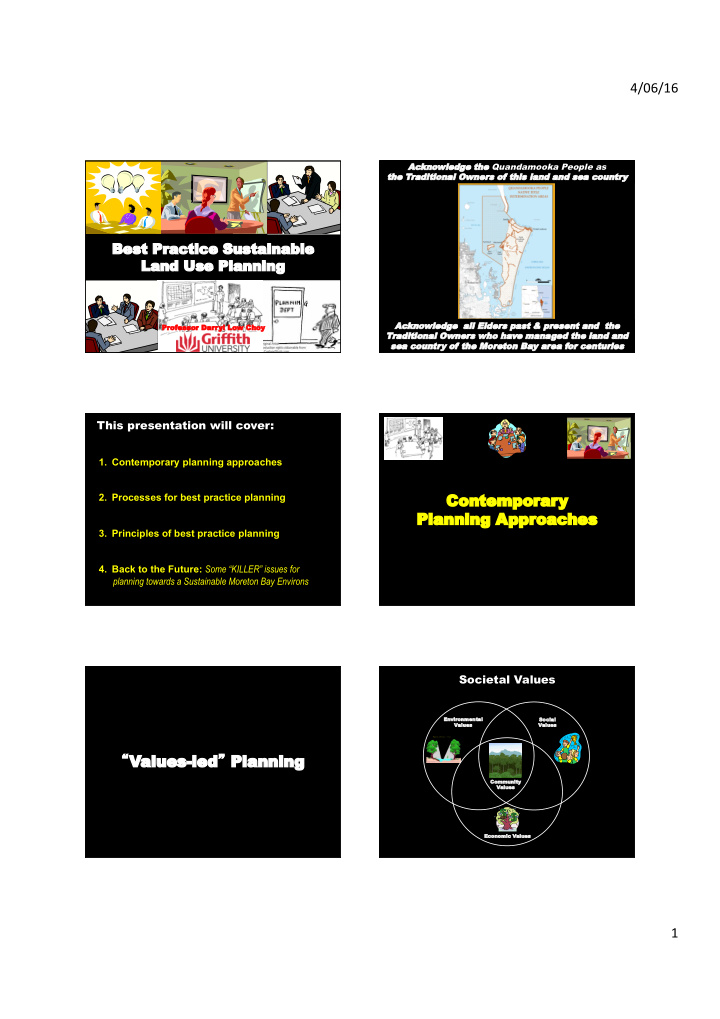



4/06/16 ¡ Ackno knowledge ledge the he Quandamooka People as the he Tradit aditional ional Ow Owner ners of of this his land land and and sea ea count country Bes est Pract actice ice Sus ustaina ainable ble Land Land Us Use e Planning lanning Source: ¡Na0onal ¡ Na0ve ¡Title ¡ Tribunal ¡(2011) ¡ Ackno knowledge ledge all all Elder lders pas past & pr pres esent ent and and the he Prof ofes essor or Dar arryl l Lo Low Cho hoy Tradit aditional ional Ow Owner ners who ho ha have e mana managed ged the he land land and and sea ea count country of of the he Mor oret eton on Bay ay ar area ea for or cent centur uries ies This presentation will cover: 1. Contemporary planning approaches Cont ontempor emporar ary 2. Processes for best practice planning Planning lanning Appr pproac oaches hes 3. Principles of best practice planning 4. Back to the Future: Some “KILLER” issues for planning towards a Sustainable Moreton Bay Environs Societal Values Envir ironment onmental al Social ocial Values alues ¡ Values alues ¡ “ Values alues-led -led ” Planning lanning Communit ommunity Values alues ¡ Economic conomic Values alues ¡ 1 ¡
4/06/16 ¡ Community (Landscape) Values Scenic ¡Amenity ¡ Outdoor ¡ Habita,on ¡ ¡ Values ¡ Recrea,on ¡Values ¡ Values ¡ “ Science cience inf infor ormed med ” Indigenous ¡ Values ¡ Planning lanning Contested Landscape Rural ¡Produc,on ¡ Values ¡ Cultural ¡Heritage ¡ Values ¡ “ Evidence idence bas based ed ” Planning lanning Biodiversity ¡ Values ¡ Ecosystem ¡ Services ¡ ¡ A Science cience Inf nfor ormed med Planning lanning Appr pproac oach h Climate ¡Sciences ¡ Ci,zen ¡Sciences ¡ Water ¡Sciences ¡ Planning lanning @ the he “ lands landsca cape pe scale cale ” Physical ¡Sciences ¡ Socio-‑economic ¡ Sciences ¡ Indigenous ¡ Knowledge ¡ (Landscape Approach) Technological ¡ Biological ¡Sciences ¡ Sciences ¡ Lands Landsca cape pe Scale cale “ …an area, as perceived by people, whose character is the result of the actions and interactions of natural and/or human factors ” (Selman, 2006: 6) Zone of Resilience Interests Biophysical Socio- Socio-economic Strategic gic (long long ter erm) m) environment ecological environment systems (Human use and occupation) Planning lanning Landscape scale Proactive – no surprises! The he Met etropolit opolitan an Region gion 2 ¡
4/06/16 ¡ Strategic gic Plans lans Typical Timelines for strategic plans Community Community Vision Vision ‘ Joined-up ’ Planning lanning ¡ ¡ rowing ¡in ¡the ¡same ¡direc0on ¡ Policies & Programs Pres esent ent 2040s 2040s (~25+ years) Alignment of Regional NRM Plan with Linking Land Linking Land Us Use e Planning lanning (Polic olicy) wit ith h Regional Land Use Plan Inf nfras astruct uctur ure e Planning lanning (Inves estment ment) Vision Vision DROs Aspirational Targets Principles Resource Condition Targets • Physical Infrastructure Policies (targets) Management • Social ? Action Targets Whole-of- Government Regulations Coordination for Infrastructure Infrastructure provision • Environmental Infrastructure Joined-up Plans Integration Processes for Best Practice Planning Linkage 3 ¡
4/06/16 ¡ Cyclic (Continuous) Planning Process A Cyclic Planning Approach with an Adaptive Management Framework Vis ision, ion, Goals Goals & Object Objectiv ives es New Learnings New Growth Projections Next Plan Planning lanning and and New Science Learning Lear ning Proces ocess Des esign ign Monit onitor or, , evalua aluate e Implement mplementation ion & repor eport Sign Posts Levels of Community Engagement Planning lanning wit ith h the he Communit ommunity Informing ¡– ¡Consul0ng ¡– ¡Involving ¡– ¡Collabora0ng ¡ – ¡Empowering ¡ ¡ Increasing ¡level ¡of ¡engagement ¡and ¡community ¡influence ¡ (embracing a community engagement approach) Source: IAP2 Barriers to Community Engagement Principles of Best Practice Planning Planning Activity (based ¡on: ¡Low ¡Choy, ¡2002) ¡ ¡ 4 ¡
4/06/16 ¡ Planning lanning wit ith h Uncer Uncertaint ainty Precautionary Principle Principle of Subsidiarity Principle 15 of the Rio Declaration states that: Where there are threats of serious or irreversible environmental damage, lack of full scientific certainty should not be used as a reason for Pre-requisite for sustainable decision-making: postponing measures to prevent environmental degradation (UNCED, 1992) Maximum transfer of power down the bureaucratic hierarchy Key components: • taking preventative action when uncertain; • making sure the advocates of an activity are responsible for the burden of proof; • investigating a wide range of possibilities and alternatives. (Kriebel, et al., 2001) Principle of Ecological Sustainable The Integration Principle Development (ESD) Decision making processes should ESD defined as: ¡ “ using, conserving and effectively integrate both long term and enhancing the community ’ s resources short term economic, social and so that ecological processes, on which environmental outcomes to recognise and life depends, are maintained, and the build on the distinctive characteristics of total quality of life, now and in the future urban places and regions, including their can be increased ” (CoA, 1992a: 60: 6) human and cultural values, history and Integrated Planning Act 1997 as amended natural systems Sustainable Planning Act 2009 as amended Planning Act 2016: Ecological sustainability Principles of Resilience The Biodiversity Pr inciple Def efinit inition: ion: Resilience is the capacity of a system to absorb disturbance to undergo change and still retain essentially the same function, structure and feedbacks. The intrinsic value of biological diversity A Res esilience ilience Appr pproac oach h (Par aradigm) adigm) requires a planning and ecological integrity should be a perspective that accepts: fundamental consideration in decision 1. “ Limits to Growth ” making and the characteristics of 2. “ Carrying Capacity ” ecosystems build on in the development 3. ecological footprint and nurturing of healthy and sustainable 4. thresholds (tipping points); urban and regional landscapes 5. system redundancy; and 6. the need to adapt 5 ¡
Recommend
More recommend